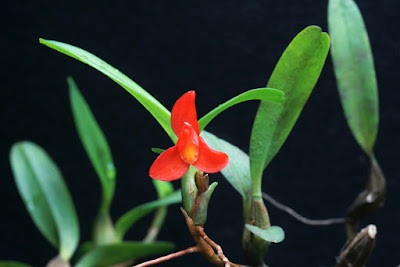Maxillaria sophronitis is native to North Venezuela. These orchids grow in mountain rainforests or on their outskirts, at heights of 760-1520 m. They are found mainly in the coastal mountains, but they were also found further away from the shores, inland...
Maxillaria sophronitis also called as The Sophronitis-Like Maxillaria, Ornithidium sophronitis, is a species of the genus Maxillaria. This species was described by Leslie Andrew Garay in 1958.
IDENTIFY MAXILLARIA SOPHRONITIS
Maxillaria sophronitis is native to North Venezuela. These orchids grow in mountain rainforests or on their outskirts, at heights of 760-1520 m. They are found mainly in the coastal mountains, but they were also found further away from the shores, inland.
It is a dwarf, epiphytic, mat forming, cool to warm growing species, which reaching 3.2 cm in size, with a rhizome enveloped by brown sheaths carrying ovoid, compressed, dull brown, 1.2 cm long pseudobulbs subtended by 1 or 2 leaf bearing sheaths and carrying a single, apical, oblong-elliptic, minutely apiculate, coriaceous, 2 cm long leaf.
The Sophronitis-Like Maxillaria blooms, dwarfing the plant, on a basal, 1 1/2" (4 cm) long, single flowered inflorescence arising on a mature prominent, unifoliate pseudobulb as a new growth arises that is subtended by a bract, occurring in the fall and early winter. The flowers are 2.5 cm in diameter and can last for 4-6 weeks. The flowers are very magnificent with bright orange-red petals of the perianth and an orange-yellow lip, whose side plots and margins are creamy-yellow. The wide, sharpened outer petals are spread out wide while the slightly shorter and blunted inner petals are tilted forward, embracing a pale green bar with a white anther.
MAXILLARIA SOPHRONITIS CARE AND CULTURE
Cultural information should only be used as a guide, and should be to be adapted to suit you. Your physical location; where you grow your plants, how much time you have to devote to their care, and many other factors, will need to be taken into account. Only then can you decide on the cultural methods that best suit you and your plants.
Light:
Maxillaria sophronitis needs a light level of 18000-25000 lux. Strong air movement should be ensured all the time.
Temperature:
It is a plant with moderate thermal requirements. In summer, the average daytime temperature is 24-25 ° C, at night 14-16 ° C, with a daily amplitude of 9-10 ° C. The average winter temperature is 26-27 ° C and at night 12 ° C, with a daily amplitude of 13-15 ° C.
Humidity:
The Sophronitis-Like Maxillaria needs the humidity of about 75-80% for most of the year, at the end of winter and early spring, falling to about 60-65%.
Substrate, growing media and repotting:
It is easier to grow Maxillaria sophronitis attached to tree-trunks or cork due to the spreading and creeping habit. The mounted plants require high humidity and watering at least once a day in the summer. If the plants are grown in pots, any loose, fast-drying substrate can be used. You can repot after observing the growth of new roots.
Watering:
During active growth from late spring to early autumn, the substrate of the plants should be wet, but in autumn watering should be gradually reduced.
Fertilizer:
Maxillaria sophronitis should be fertilized every week 1/4-1/2 of the recommended dose of fertilizer for orchids. A fertilizer with a high nitrogen content is beneficial from spring to mid-summer, and a fertilizer richer in phosphorus should be used in late summer and autumn.
Rest period:
In winter, watering of cultivated plants should be limited, but must not be allowed to stay dry for a long time. Fertilization should be limited or should be completely abandoned until spring, when stronger watering resumes.

















COMMENTS